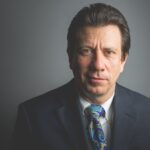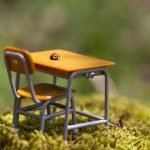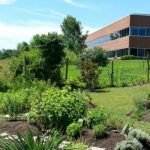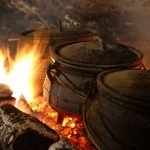FRASER SMITH, MATD, ND
With the sun shining, the days getting long, and 2021 at its halfway-point at the time of this writing, it seems like a good moment to reflect on June 2020 versus June 2021. It’s been an unprecedented 12 months for naturopathic medical education and the profession. In a recent conference call for the Naturopathic Medicine Collaborative, where most, if not all, of our many organizations in this profession had an opportunity to update each other on what’s new, I shared that I felt like the spring is a collective version of Elton John’s 1983 hit single, “I’m still standing.” Not only does Sir Elton say he’s feeling like a “true survivor”; he also says, “I’m still standing better than I ever did.” That’s not far off from where our colleges are, and that is remarkable.
Reasons to Celebrate:
The Class of COVID
We are now seeing graduates in the profession who had their clinical training interrupted by the pandemic. All naturopathic graduates deserve applause, and none more than this cohort. They rose to the occasions of entirely new ways to work with patients, be it the continuous use of personal protective equipment while on the job, or increased use of telemedicine visits. The pre-clinical students deserve a shout-out as well, as the course delivery of their program shifted dramatically in a matter of weeks in March of 2020. Pile on top of that the stress of lockdowns, not interacting with their classmates in the usual ways, the danger of (and sometime actual) loss of loved ones and friends, and economic hardships. These students refused to quit.
Super-Colleges
Our colleges had to revamp much of their delivery of education, and then change it again from mostly online to partially online, all in a dizzying time-span. Like many sudden mobilizations, there are things done well, things done well enough, and lessons learned from things poorly executed. In June of 2020, we were a couple months into the brave new world of online learning. Would the students – and faculty – be able to maintain their focus without the usual classroom routines? Would students tire of the long days at the computer and press a collective “pause” on their naturopathic programs, or even make other arrangements? Very significantly, would the students learn what they needed to learn?
Farewells
With 1 more cohort to put through clinic, we’ve seen the winding down of the Naturopathic College at the University of Bridgeport. That decision was at the university level, but at the program level there was a great community of students, scholar-practitioners, and administrators. The dean, Dr Marcia Prenguber, is one of our profession’s great examples of what I would call “servant-leadership.” Her many roles and activities included President of CNME, clinician and residency supervisor at Goshen Cancer Hospital, her long-term efforts to grow naturopathic residencies via the Naturopathic Post-Graduate Association, and her work at Bridgeport.
This past year also saw the (very recent) passing of Jim Spring, ND, DC, among others.1 Dr Spring was President of the North American Board of Naturopathic Examiners (NABNE) for many years and was extremely instrumental in Ontario’s naturopathic profession. He was just one of those people who gives and gives.
Mergers and Evolutions
As the song goes, “from Bonavista to Vancouver Island,” Canada is a very large country. It has a thriving naturopathic medicine profession as well as great public interest in it. But concentrating resources and enrollment in any geographic area is challenging. In the past year, 2 excellent Canadian naturopathic colleges – the Boucher Institute for Naturopathic Medicine (BINM) and the Canadian College of Naturopathic Medicine (CCNM) – chose a destiny of synergy. The 2 institutions merged under the banner of CCNM.2 Both sites remain, and the change makes these 2 programs stronger together. The new identity forged by this cross-country amalgam also bodes very well for the future of naturopathic medicine and what is effectively the largest naturopathic college in the world. Our other programs carried on as well, and exciting things are in the air this summer. Overall, the ongoing return to in-person learning has gathered momentum at the colleges. We are all recruiting new people to fill faculty and leadership positions from the increasingly large talent pool in naturopathic medicine and beyond.
The American Association of Naturopathic Physicians has planned the annual AANP convention3 (and this wonderful week will have passed by the time of this publication). It is returning to the popular Biltmore Resort site in Phoenix and, in an evolutionary step, is hybrid. Some attendees will book a room at the resort and go to the live sessions, and others will join online. Some presenters are online, and many are in person. This evolution is a great example of how we’ve adapted and grown stronger through a challenge. This is more evidence that the “Vis” of the profession is vibrant.
Green Shoots and Deep Roots
Bastyr University has announced a new president – Dr Devin Byrd – who brings a wealth of leadership experience.4 Several of the naturopathic programs have new deans or chief medical officers who started new roles or are about to. Talent seems to flow where it is needed, and the gravitational pull of our awesome mission (and the commitment that propels it forward) is attractive to those within the profession and to those joining us from the wider field of higher education.
Did a year of interruptions and adaptations in higher education neutralize the enthusiasm of potential students of naturopathic medicine? Apparently, it did not. New students started in our programs in 2020, and as summer of 2021 moves along, we have robust incoming classes for Fall 2021. I don’t have any solid data, but my sense is that many people have seen that a certain self-reliance and self-care is more important than ever. Hospitals and ICUs can be marvels when we desperately need them, but the consciousness may be growing that the goal is to stay away from those places as much as possible. Likewise, today’s soon-to-be naturopathic students are seeing, in their own way and in their own time, the great need that naturopathic medicine can fill.
Turn, Turn, Turn
There have been some turning of pages and turning, perhaps, of one era to another during this past year. A survey of healthcare utilization, conducted by Price Waterhouse Cooper,5 found that consumers want more in-home health care. That can be telemedicine (which naturopathic doctors have been very quick to make even more use of) or even house calls. With our very personalized approach, we are well positioned to deliver that kind of service. The shock and awe of large medical group offices, replete with waterfalls and huge reception areas, is perhaps losing its appeal. Patients seem to want more care at home on their own time – a throwback to days gone by when doctors made their rounds. The twist is that these rounds might very well be virtual, though no less convenient than in-person rounds, and more “on demand” for the patient. This same report by PWC found that clinical trials are moving out of hospitals and into distributed sites. This seems positive for naturopathic medicine as well, as the sites for our research are more likely to be community-based rather than a large teaching hospital.
Another important turning is a growing awareness of health disparities and the effects of racism on health care access, delivery, diagnosis, treatment, and outcomes. This long-overdue awareness is gaining momentum, and our naturopathic colleges are moving in the right direction. More course content on these important public health and patient quality-of-care issues is materializing. There is plenty more to do here. Recently a student asked us to look at our teaching of Psychological Diagnosis – in the DSM V-type categories. The impact of biases in drawing conclusions about prevalence of conditions in any minority, including African Americans, demands consideration.6 The lessons we impart to our students, in terms of how to apply this knowledge to these populations, are essential. As we redevelop courses like this, we can pay close attention to these problems. Likewise, across any of our colleges’ curriculum, there are opportunities to add a dimension to the curriculum and the course activities that includes racial biases – individual and systemic, medical and socioeconomic.7 We must take these opportunities. It seems that the past 12 months have seen an important shift.
When Life Gives You Lemons…
Surviving a pandemic is in itself a reason to be grateful. Our profession, the doctors and their practices, our agencies, and our colleges, have plenty of reasons to dance and laugh together at the AANP reception this year. Are the changes themselves good, or are they simply things we have to make the best of in naturopathic education as we somehow “muddle through”? I believe they are good. We have fewer names on the Association of Accredited Naturopathic Medical Colleges (AANMC) banner this year, but we have strong schools. (And to keep up with these things, remember that www.annmc.org is a great resource.)
The growth of our educational network is far from over. We have all become more adept at using online learning, including real-time “Zoom”-type online learning and so-called “asynchronous” learning that allows students to self-pace across a weekly unit. Are we sliding into becoming correspondence schools, all thanks to COVID? That is not the case: The nature of our training, its human centeredness, our accreditation system, and the simple need for students to learn to care for people by being with people, all preclude us from taking online learning to an extreme. But the flexibility does free students from a crushing amount of seat-time. It does give them some control in their schedules, and it allows for new ways to deliver courses. Likewise, although we now have a level of telemedicine competence that we didn’t before (simply because we had not used it “hard-core” for a full year), naturopathic care in our colleges’ clinical systems will still be grounded in the patient visit.
A Lasting Model
Maybe what we have learned is that all the work, and all the growth and development of our naturopathic education system, from the time that NCNM emerged in the 1950s to now, has not been for naught. We, and those powerful people who put this together, created a model built to last. As we think through changes in our world, the needs of our current students and patients, and where the field is heading, we have an opportunity to also build a model that will last.
References:
- Legacy. James W. Spring DC, ND: 1053-2021. Available at: https://www.legacy.com/obituaries/hamiltonnews/obituary.aspx?n=james-w-spring&pid=199112627&fhid=41349. Accessed June 29, 2021.
- Canadian College of Naturopathic Medicine. Merger Establishes a Global Leader in Naturopathic Medical Education and Research in Canada. November 17, 2020. CCNM Web site. https://www.ccnm.edu/about-ccnm/news/binm. Accessed June 23, 2021.
- American Association of Naturopathic Physicians. July 15-17 | Hybrid Convention 2021. AANP Web site. https://naturopathic.org/general/custom.asp?page=AANP2021. Accessed June 23, 2021.
- Bastyr University. Dr. Devin Byrd Appointed Sixth President of Bastyr University. June 18, 2021. Bastyr Web site. https://bastyr.edu/news/general-news-home-page/2021/06/dr-devin-byrd-appointed-sixth-president-bastyr-university. Accessed June 21, 2021.
- Price Waterhouse Cooper. Redesigning healthcare for the consumer: Survey insights from PwC’s Health Research Institute. 2020. PWC Web site. https://www.pwc.com/us/en/industries/health-industries/library/hri-insight-consumer-health-behavior-and-covid-19-pandemic.html. Accessed June 21, 2021.
- Kerner J, McCoy B, Gilbo N, et al. Racial Disparity in the Clinical Risk Assessment. Community Ment Health J. 2020;56(4):586-591.
- Williams DR, Lawrence JA, Davis BA. Racism and Health: Evidence and Needed Research. Annu Rev Public Health. 2019;40:105-125.

Fraser Smith, MATD, ND is Assistant Dean of Naturopathic Medicine and Professor at the National University of Health Sciences (NUHS) in Lombard, IL. Prior to working at NUHS, he served as Dean of Naturopathic Medicine at the Canadian College of Naturopathic Medicine (CCNM) in Toronto, Ontario. Dr. Smith is a licensed naturopathic physician and graduate of CCNM.





